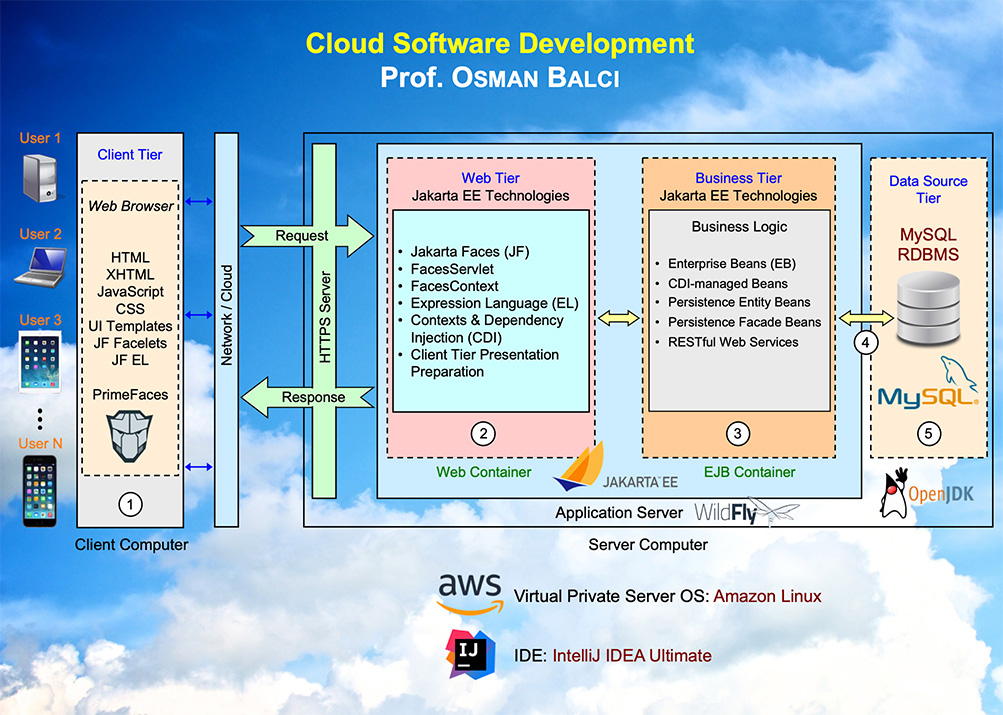| Course Description | ||||||||||||||||||||||||
The primary objective of this course is to teach the fundamentals of software engineering throughout the entire software life cycle. The course focuses on cloud software engineering. After covering the Problem Formulation process, a use-case-based approach is introduced for the Requirements Engineering life-cycle process. Architecting cloud-based software system of systems is covered by using the Department of Defense Architecture Framework (DoDAF). Object-oriented software Design is introduced by using the Unified Modeling Language (UML). Programming is taught with hands-on step-by-step tutorials by using the IntelliJ IDEA Ultimate, MySQL relational database server, and WildFly application server on the Java platform Jakarta Enterprise Edition (Jakarta EE). Related software engineering topics such as the following are also covered: Software Life Cycle Models, Virtualization technologies – Underpinnings of the Cloud Computing, Software Decomposition / Modularity, Guidelines for User Interface Design, Principles and Techniques of Verification and Validation (V&V) and Quality Assurance (QA), and CMMI for Development (CMMI-DEV). Doing things “in the cloud” has become ubiquitous, and cloud has become a rich new environment for the use of technology anywhere and anytime to solve problems, connect people, and improve lives. Software paradigm has been shifting from “Software-as-a-Product (SaaP)” to “Software-as-a-Service (SaaS)” provided “in the cloud”. The SaaS software paradigm comes with capabilities and technical challenges for cloud software development, as compared to mobile and stand-alone software development. Distributed multitiered software architecting, design, and programming for the cloud platform require different strategies specifically motivated by this paradigm. This course gives students the opportunity to learn how to develop software for this important computing context. It also gives them a rich context in which to practice and reinforce the fundamental concepts of object-oriented software design and implementation taught in previous courses. The course introduces the fundamentals, design patterns, interfaces, frameworks, and technologies underlying cloud software development. It teaches hands-on how to develop distributed multitiered enterprise software applications that run on a server computer and used by a user with a web browser over the Internet on a network-connected computer such as desktop, laptop or handheld computer (tablet, smartphone, or mobile device). The course focuses on the Java platform Jakarta Enterprise Edition (Jakarta EE). It teaches Jakarta EE technologies such as Jakarta Faces (JF), Expression Language (EL), Contexts and Dependency Injection (CDI), Enterprise Beans (EB), PrimeFaces library of user interface components for JF, Jakarta Persistence, and RESTful Web Services as depicted in the client-server architecture poster below.  The course employs the “Learning by Examples” pedagogy. In class meetings, students develop a cloud software application with hands-on, step-by-step, and hypertext-based instructions. Students work in a team to develop a cloud software application in their semester project to solve a complex problem as their crowning achievement in the course. The course employs:
Students obtain an Amazon Elastic Compute Cloud (Amazon EC2) server computer virtualized instance running Amazon Linux operating system as their Virtual Private Server for deploying their cloud software applications developed in the course. |
||||||||||||||||||||||||
| Learning Objectives | ||||||||||||||||||||||||
Having successfully completed this course, students will be able to:
|
||||||||||||||||||||||||
| Prerequisites | ||||||||||||||||||||||||
|
||||||||||||||||||||||||
| Materials | ||||||||||||||||||||||||
Each student is required to bring a Mac, Windows or Linux laptop computer to each class meeting for hands-on learning of cloud software development. The laptop computer must be running IntelliJ IDEA Ultimate, WildFly Application Server, and MySQL which are used for cloud software development in the course. A powerful laptop connected to a large monitor or a desktop with large monitor is recommended for improved productivity. |
||||||||||||||||||||||||